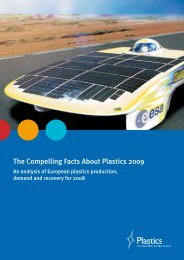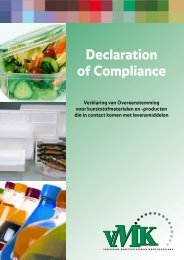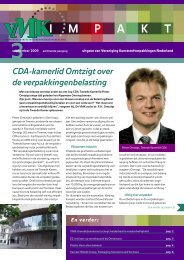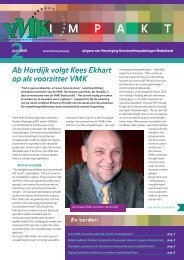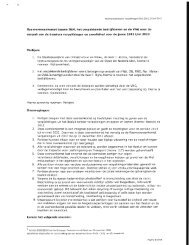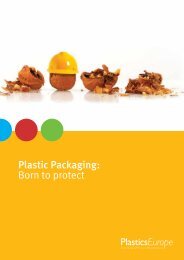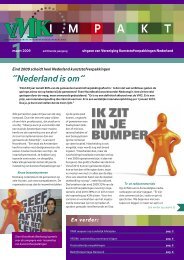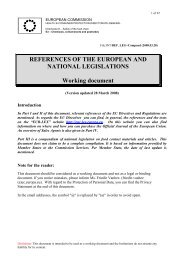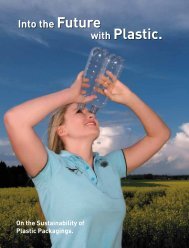food contact materials - European Commission - Europa
food contact materials - European Commission - Europa
food contact materials - European Commission - Europa
- No tags were found...
Create successful ePaper yourself
Turn your PDF publications into a flip-book with our unique Google optimized e-Paper software.
42080 Carbon black Specifications:• Toluene extractables: maximum 0,1 %, determined according to ISO method 6209.• UV absorption of cyclohexane extract at 386 nm: < 0,02 AU for a 1 cm cell or < 0,1 AU for a 5 cm cell,determined according to a generally recognised method of analysis.• Benzo(a)pyrene content: max 0,25 mg/kg carbon black.• Maximum use level of carbon black in the polymer: 2,5 % w/w43480 Charcoal, activatedTo be used only in PET at maximum 10 mg/kg of polymer. Same purity requirements as for Vegetable Carbon (E 153)set out by <strong>Commission</strong> Directive 95/45/EC laying down specific purity criteria concerning colours for use in<strong>food</strong>stuffs 1 with exception of ash content which can be up to 10% (w/w).43680 ChlorodifluoromethaneContent of chlorofluoromethane less than 1 mg/kg of the substance47210 Dibutylthiostannoic acid polymerMolecular unit = (C 8 H 18 S 3 Sn 2 )n (n=1.5-2)60025 Specifications:- Minimum viscosity (at 100°C) = 3.8 cSt- Average Mw>45060027 Hydrogenated homopolymers and/or copolymers made of 1-hexene and/or 1-octene and/or 1-decene and/or 1-dodecene and/or 1-tetradecene (Mw: 440-12000)Average molecular weight not less than 440 DaViscosity at 100 °C not less than 3,8 cSt (3,8 x 10-6 m 2 /s)64990 Maleic anhydride-styrene, copolymer, sodium saltMW fraction < 1000 is less than 0,05% (w/w)67155 Mixture of 4-(2-Benzoxazolyl)-4'-(5-methyl-2-benzoxazolyl)stilbene, 4,4'-bis(2-benzoxazolyl) stilbene and 4,4'-bis(5-methyl-2-benzoxazolyl)stilbene)Mixture obtained from the manufacturing process in the typical ratio of (58-62%):(23-27%):13-17%).72081/10 Petroleum hydrocarbon resins (hydrogenated)Specifications:Petroleum hydrocarbon resins, hydrogenated are produced by the catalytic or thermal polymerisation of dienes andolefins of the aliphatic, alicyclic and/or monobenzenoid arylalkene types from distillates of cracked petroleum stockswith a boiling range not greater than 220 °C, as well as the pure monomers found in these distillation streams,subsequently followed by distillation, hydrogenation and additional processing.Properties:Viscosity: > 3 Pa.s at 120 °C.Softening point: > 95 °C as determined by ASTM Method E 28-67.Bromine number: < 40 (ASTM D1159)The colour of a 50 % solution in toluene < 11 on the Gardner scaleResidual aromatic monomer ≤ 50 ppm76721 Polydimethylsiloxane (Mw>6800)Minimum viscosity 100x10 -6 m 2 /s (=100 centistokes) at 25 o C76723 Specifications:The fraction with molecular weight below 1000 should not exceed 1.5% w/w76725 Specifications:The fraction with molecular weight below 1000 should not exceed 1 % w/w76815 Polyester of adipic acid with glycerol or pentaerythritol, esters with even numbered, unbranched C12-C22 fatty acidsMW fraction < 1000 is less than 5% (w/w)76845Polyester of 1,4-butanediol with caprolactoneMW fraction < 1 000 is less than 0,5 % (w/w)77708 Polyethyleneglycol (EO = 1-50) ethers of linear and branched primary (C 8 - C 22 ) alcoholsMaximum residual quantity of ethylene oxide in the material or article = 1 mg/kg* OJ L 339, 30.12.1996, p. 1.”1 OJ L 226, 22.9.1995, p.1. Directive as last amended by Directive 2004/47/EC (OJ L 113 , 20.4.2004, p.24).2 Quantity of substance used /quantity of formulation35 of 41



